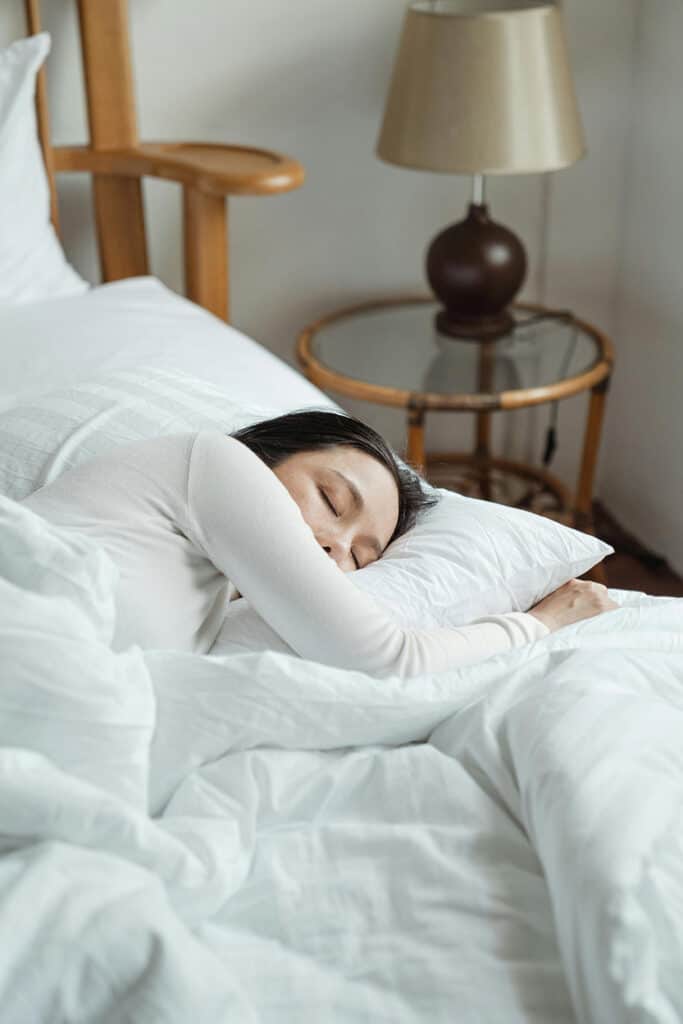

Struggling to find that elusive good night’s sleep? Are restless nights and groggy mornings becoming all too familiar? As someone who values rejuvenating rest, you deserve a solution that not only promotes relaxation but also enhances the quality of your sleep.
As a seeker of serenity in a fast-paced world, achieving deep, restorative sleep is your ultimate goal. You’re not alone in this quest for peaceful nights and energized mornings.
At Life Tree Planner, we understand the frustration of sleepless nights and the impact they have on your well-being.
With a passion for the science behind relaxation and over years of expertise in therapeutic music, we’re here to guide you towards nights filled with tranquil sleep.
Ready to reclaim your nights and wake up refreshed? By incorporating deep sleep music into your routine, you’ll unlock the door to a world of improved sleep quality and overall well-being.
Say goodbye to restless nights and hello to rejuvenating mornings, all with the power of soothing melodies at your fingertips.
- Benefits of Deep Sleep Music
- Science Behind Deep Sleep Music
- Types of Deep Sleep Music
- Sleep Issues
- Apps and Websites
- History and Origins of Sleep Music
- Lucid Dreaming and Dream Recall
- Deep Sleep Music vs. White Noise
- Sleep Music for Babies and Children
- Meditation and Mindfulness Practices
- Deep Sleep Music: A Recap
Here are 10 types of deep sleep music:
- Ambient Music: Atmospheric sounds for relaxation and sleep.
- Classical Music: Soothing melodies reduce stress and aid sleep.
- Nature Sounds: Rain, waves, or birdsong create a calming environment.
- Instrumental Music: Calm music without vocals for relaxation.
- Meditation Music: Promotes deep relaxation and calm.
- White Noise: Blocks distractions for uninterrupted sleep.
- Binaural Beats: Influences brainwaves for relaxation.
- Delta Wave Music: Stimulates deep sleep brainwaves.
- Isochronic Tones: Synchronizes brainwaves for relaxation.
- Guided Imagery Music: Combines music with calming mental imagery.
See also Selfcare Reminders: 10 Mindful Moments in Daily Life as a Routine
Benefits of Deep Sleep Music

Deep sleep music offers a multitude of benefits for those seeking relaxation and improved sleep quality. By incorporating soothing melodies and gentle rhythms, this genre of music creates an atmosphere conducive to deep relaxation, helping to calm the mind and body.
Through music therapy techniques, deep sleep music can alleviate stress and anxiety, promoting a sense of tranquility before bedtime.
Research suggests that listening to relaxing sleep music can also enhance sleep efficiency and duration, leading to a more restorative night’s rest. Whether incorporated into a nightly playlist or utilized during moments of deep relaxation, deep sleep music offers a powerful tool for promoting overall well-being.
Here are 10 benefits of deep sleep music:
- Promotes Relaxation: Deep sleep music induces a state of relaxation, reducing stress and anxiety levels.
- Enhances Sleep Quality: It helps in achieving deeper and more restorative sleep cycles.
- Improves Sleep Patterns: It can regulate sleep patterns, making it easier to fall asleep and wake up naturally.
- Reduces Insomnia: Listening to soothing music before bed can alleviate symptoms of insomnia.
- Creates a Calming Atmosphere: It fosters a peaceful environment conducive to sleep.
- Decreases Heart Rate and Blood Pressure: Music can help lower physiological responses associated with stress.
- Enhances Mental Clarity: Better sleep quality leads to improved cognitive function and alertness during the day.
- Alleviates Pain: Music therapy has been shown to reduce chronic pain and discomfort, aiding in better sleep.
- Boosts Mood: It can uplift mood and create a positive emotional state.
- Accessible and Affordable: Deep sleep music is readily available and cost-effective compared to other sleep aids.
Science Behind Deep Sleep Music

Deep sleep music leverages principles of neuroscience and psychology to induce a relaxed state conducive to deep sleep.
Here are 8 aspects of the science behind it:
- Brainwave Entrainment: Music with specific beats or frequencies can synchronize brainwaves with the music’s rhythm, promoting relaxation and sleep.
- Reduction of Stress Hormones: Listening to calming music before bed decreases cortisol levels, the stress hormone, facilitating a more relaxed state.
- Activation of Parasympathetic Nervous System: Slow-tempo music stimulates the parasympathetic nervous system, responsible for promoting relaxation and rest.
- Improvement of Sleep Architecture: Deep sleep music can enhance sleep quality by influencing sleep stages, particularly increasing the duration of deep sleep phases.
- Emotional Regulation: Music’s impact on emotions can alleviate anxiety and emotional tension, further promoting relaxation essential for falling asleep.
- Attention Diversion: Engaging music can redirect attention from intrusive thoughts or worries, helping individuals unwind and prepare mentally for sleep.
- Cognitive and Behavioral Conditioning: Consistent use of deep sleep music can condition the brain to associate specific music cues with relaxation and bedtime, aiding in faster sleep onset.
- Integration with Other Relaxation Techniques: Combined with techniques like deep breathing or progressive muscle relaxation, deep sleep music can amplify its sleep-inducing effects.
Overall, the science supports deep sleep music as an effective, non-invasive intervention for improving sleep quality and promoting overall well-being.
Types of Deep Sleep Music

Types of Deep Sleep Music refers to the various genres, styles, and compositions of music specifically designed to promote relaxation, induce sleep, and improve the quality of sleep. These may include:
1. Ambient Music
Ambient Music Characterized by atmospheric sounds and textures, ambient music creates a soothing and calming environment conducive to sleep.
2. Classical Music
Pieces from classical composers like Mozart, Bach, and Debussy are often used for their tranquil melodies and rhythmic patterns that can induce relaxation.
3. Nature Sounds
Recorded sounds of nature such as rain, ocean waves, birdsong, or forest ambiance can create a natural and serene atmosphere for sleep.
4. Instrumental Music
Instrumental compositions featuring instruments like piano, guitar, flute, or strings are often chosen for their gentle melodies and lack of distracting lyrics.
5. Meditation Music
Music designed for meditation purposes often incorporates repetitive patterns, soft tones, and slow tempos to promote relaxation and mindfulness, making it suitable for sleep as well.
6. White Noise
Consisting of a constant, unvarying sound, white noise masks other noises and distractions, helping to create a consistent background for sleep.
7. Binaural Beats
These are auditory illusions created by playing slightly different frequencies in each ear, believed to induce brainwave synchronization and promote relaxation and sleep.
8. Delta Wave Music
Delta waves are associated with deep sleep stages, and music engineered to stimulate delta brainwave activity may facilitate deep and restorative sleep.
9. Isochronic Tones
Similar to binaural beats, Isochronic tones are repetitive audio pulses believed to influence brainwave activity and promote relaxation and sleep.
10. Guided Imagery Music
Combining music with guided imagery or visualization techniques, this type of music encourages relaxation and helps quiet the mind for sleep.
See also The Art of Selfcare: 10 Practices of Well-Being and Wellness
Sleep Issues

Sleep issues encompass a range of difficulties that interfere with normal sleep patterns and quality.
Here are 8 common types of sleep issues:
- Insomnia: Difficulty falling asleep or staying asleep, leading to inadequate sleep duration or poor sleep quality.
- Sleep Apnea: Breathing pauses during sleep due to airway obstruction (obstructive sleep apnea) or disrupted signals from the brain (central sleep apnea), resulting in fragmented sleep and daytime fatigue.
- Restless Legs Syndrome (RLS): Uncomfortable sensations in the legs causing an urge to move them, often disrupting sleep.
- Narcolepsy: Neurological disorder causing excessive daytime sleepiness and sudden onset of sleep attacks.
- Parasomnias: Abnormal behaviors or movements during sleep, such as sleepwalking, nightmares, or night terrors.
- Circadian Rhythm Disorders: Disruptions in the body’s internal clock, affecting sleep-wake cycles, common in shift workers or individuals with jet lag.
- REM Sleep Behavior Disorder: Acting out vivid dreams during REM sleep, potentially causing injury to oneself or bed partner.
- Sleep-related Movement Disorders: Abnormal movements or behaviors during sleep, including periodic limb movement disorder (PLMD).
Addressing sleep issues typically involves lifestyle changes, sleep hygiene practices, and sometimes medical interventions or therapies tailored to the specific sleep disorder. Seeking professional advice is crucial for accurate diagnosis and effective treatment.
Apps and Websites

Deep Sleep Music Apps and Websites such as Calm, Headspace, and Insight Timer offer a plethora of options for those seeking tranquility and relaxation. With the hustle and bustle of modern life, finding solace in soothing melodies can be a game-changer.
Whether you’re in need of stress relief after a long day or simply craving a moment of calm, these platforms have you covered.
From curated playlists of relaxing sleep music to personalized recommendations based on your preferences, quality tracks are just a click away. Explore these apps and websites to discover the perfect soundtrack for your journey to deep, restful sleep.
History and Origins of Sleep Music

The history and origins of deep sleep music trace back to ancient civilizations, where music was revered for its therapeutic and spiritual qualities.
Historically, the use of music for therapeutic purposes dates back centuries, with ancient civilizations such as the Greeks, Egyptians, and Chinese employing music to facilitate healing and relaxation.
From the tranquil melodies of ancient Chinese and Indian music to the soothing chants of Gregorian monks, cultures worldwide have recognized the power of music to induce relaxation and aid sleep.
In the modern era, composers and musicians have further explored this concept, blending traditional and contemporary elements to create a diverse array of deep sleep music genres, each with its own unique origins and influences.
Lucid Dreaming and Dream Recall

Lucid Dreaming:
- Lucid dreaming is the state of becoming aware that one is dreaming while still in the dream.
- It allows individuals to control aspects of their dreams, such as the environment or storyline.
- Typically occurs during the rapid eye movement (REM) stage of sleep, where dreams are vivid.
5 Lucid Dreaming Techniques and Practices:
- Reality Checks: Perform regular reality checks during waking hours to encourage critical awareness that can carry over into dreams.
- Dream Journaling: Keep a dream journal to record and analyze dreams, enhancing self-awareness and improving dream recall.
- Mnemonic Induction of Lucid Dreams (MILD): Repeat affirmations or visualizations before sleep to increase the likelihood of lucid dreaming.
- Wake-Back-to-Bed (WBTB): Wake up after several hours of sleep, stay awake for a short period, then return to sleep with the intention of having a lucid dream.
- Wake-Initiated Lucid Dreams (WILD): Transition directly from waking to a lucid dream state by maintaining awareness while falling asleep.
Dream Recall:
- Refers to the ability to remember dreams upon waking up.
- Involves retrieving details and sequences from dreams experienced during various stages of sleep.
- Influenced by factors like sleep quality, waking conditions, and individual psychological traits.
5 Dream Recall Practices and techniques:
- Set Intention: Before going to bed, affirm the intention to remember dreams upon waking up.
- Keep a Dream Journal: Immediately upon waking, record any dream fragments, images, or emotions in a journal kept by the bedside.
- Stay Still: Upon waking, remain still and quiet, allowing dream memories to surface before engaging in any physical activity.
- Recall Associations: Review recent experiences, emotions, or thoughts that may trigger recall of dream content.
- Visualization: Close your eyes and mentally replay the dream, focusing on details and sensations to enhance recall.
Deep Sleep Music vs. White Noise

Deep Sleep Music:
- Designed to promote relaxation and induce deep, restorative sleep.
- Incorporates soothing melodies, gentle rhythms, and harmonious sounds.
- Often includes elements like nature sounds, soft piano music, or ambient tracks.
- Aims to calm the mind and body, reducing stress, anxiety, and mental chatter.
- Helps create a tranquil environment conducive to falling asleep and staying asleep.
- Used during bedtime routines, meditation practices, or relaxation sessions.
White Noise:
- Intended to mask background noises and create a consistent sound environment.
- Consists of a steady, unvarying sound spectrum covering a wide range of frequencies.
- Examples include the sound of a fan, rain falling, or static.
- Helps block out disruptive noises and distractions.
- Improves concentration, enhances privacy, and promotes relaxation.
- Used in bedrooms, offices, or other environments where external noises may interfere with sleep or focus.
Now, let’s list the differences between Deep Sleep Music and White Noise:
Purpose:
- Deep Sleep Music: Designed to promote relaxation and induce a state of calm conducive to deep sleep.
- White Noise: Intended to mask background noises and create a consistent sound environment for better sleep.
Composition:
- Deep Sleep Music: Incorporates soothing melodies, gentle rhythms, and harmonious sounds such as nature sounds, soft piano, or ambient music.
- White Noise: Consists of a steady, unvarying sound spectrum that covers a wide range of frequencies, such as the sound of a fan, rain, or static.
Effects:
- Deep Sleep Music: Helps to reduce stress, anxiety, and mental chatter, facilitating the transition into a restful sleep.
- White Noise: Blocks out disruptive noises and distractions, helping individuals to fall asleep and stay asleep.
Benefits:
- Deep Sleep Music: Enhances sleep quality, promotes relaxation, and may improve sleep duration.
- White Noise: Improves concentration, enhances privacy, and promotes relaxation by creating a steady background sound.
Applications:
- Deep Sleep Music: Used during bedtime routines, meditation practices, or as background music for relaxation sessions.
- White Noise: Used in bedrooms, offices, or other environments where external noises may interfere with sleep or focus.
These differences highlight the distinct purposes, compositions, effects, benefits, and applications of Deep Sleep Music and White Noise, catering to different preferences and needs for achieving better sleep.
Sleep Music for Babies and Children

Days ago, introducing relaxing sleep music for babies and children was hailed as a breakthrough in parenting. This specialized genre aids stress relief and helps relaxation, supporting little ones in achieving deeper, more restful sleep.
Designed with soothing melodies and gentle rhythms, relaxing music creates a calming environment conducive to peaceful nights, promoting overall well-being for both children and parents alike.
Meditation and Mindfulness Practices

Deep sleep music isn’t just for bedtime; it’s also a powerful tool for deep meditation and mindfulness practices.
By curating a playlist of calming and relaxing sleep music, individuals can create a serene environment conducive to deep introspection and focus.
The gentle melodies and soothing rhythms help quiet the mind, promote relaxation, and enhance mindfulness, allowing for a deeper and more meaningful meditation experience.
Try the world of deep sleep music and elevate your mindfulness practice to new heights.
See also Self-Love Books: 12 Books Nurturing Self Love and Inner Peace
Deep Sleep Music: A Recap
In conclusion, deep sleep music offers a soothing remedy for restless nights and restless minds. Since its inception days ago, its gentle melodies and calming rhythms have provided solace and serenity to countless individuals seeking respite from the chaos of everyday life.
Whether used for bedtime relaxation, meditation, or mindfulness practices, the power of relaxing music to promote deep sleep and overall well-being cannot be overstated.
Initiate the tranquil melodies of deep sleep music and start a journey towards profound relaxation and rejuvenation.


